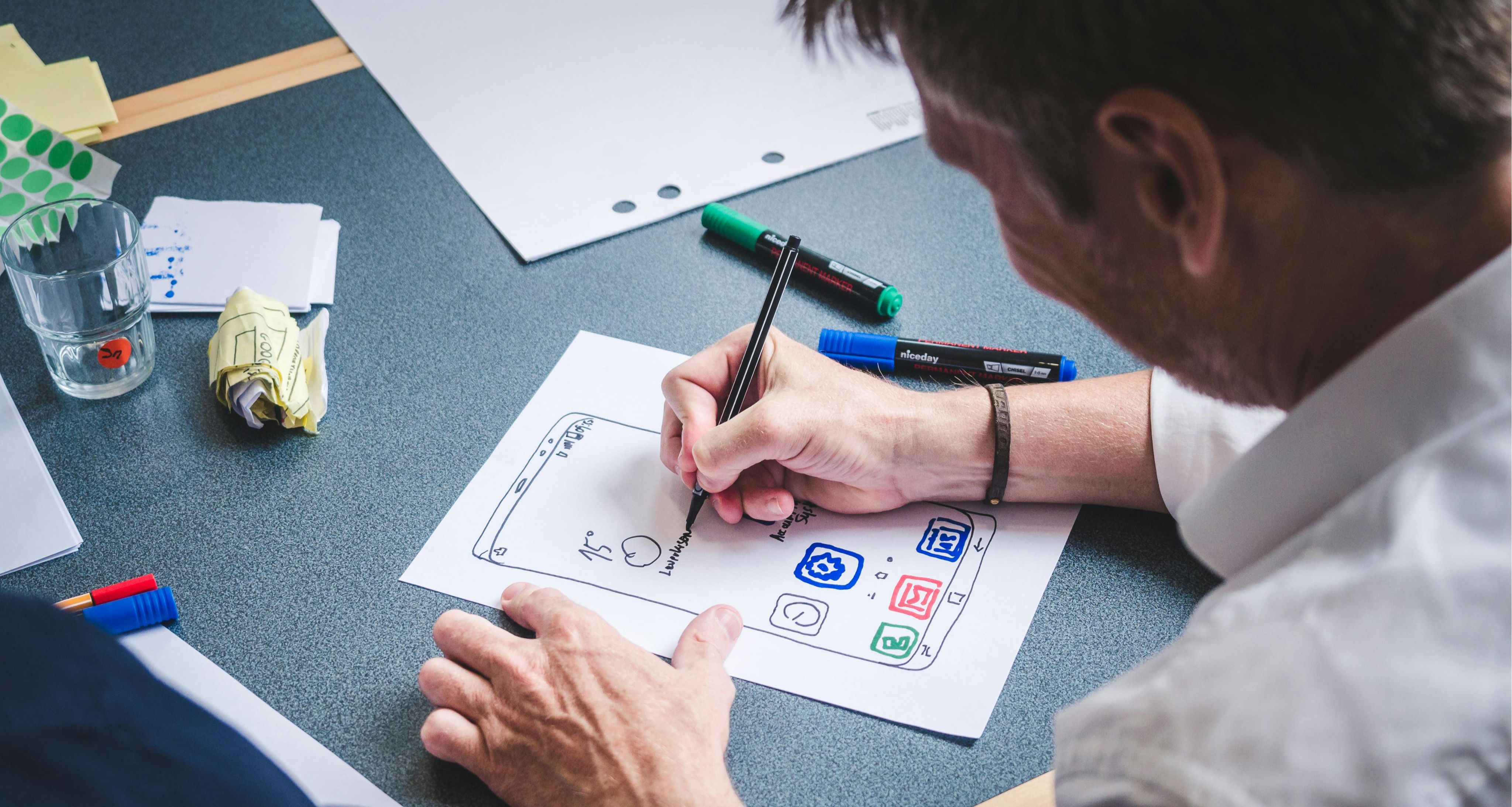Our Website Design Process
Explained
Our website design embodies intuitive navigation, sleek aesthetics, and responsive functionality tailored to enhance user experience. With a focus on seamless integration of visual appeal and usability, we craft designs that captivate, inform, and engage visitors, driving your digital presence forward.

An Introduction to the website
design process.
The quality web design process is a meticulous and structured approach to creating websites that are not only visually appealing but also functional and user-friendly. It starts with thorough planning and strategy, defining clear objectives, understanding the target audience, and conducting comprehensive market research. This foundation led to the creation of a detailed sitemap and wireframe, outlining the website’s structure and basic layout.
In the design phase, the focus is on selecting a visual style that reflects the brand’s identity and crafting a user interface (UI) that is both consistent and intuitive. Attention is given to user experience (UX) design, ensuring seamless navigation and interaction. Prototypes are developed to test the site’s functionality and flow, allowing for adjustments before development begins.
Content creation is a critical step, involving the production of high-quality, engaging text and visuals, all optimised for search engines (SEO). The development phase encompasses front-end development, translating designs into code, and back-end development, setting up servers and databases.
Rigorous testing ensures compatibility across various browsers and devices, while performance optimization enhances speed and usability. Upon launch, the website is monitored for any issues. Regular updates and performance analyses, along with staying abreast of design trends, ensure the website remains effective and relevant. This process guarantees a superior, user-centric web design.
Website Design Process
On our quotes, we often include a brief outline of what will be involved in building a new website. This can help our clients understand what they need to prepare for as well as give them an idea of how much time is required for each phase.
Discovery and Analysis
A Professional Expert in Discovery and Analysis for Web Design ensures that every project is rooted in a thorough understanding of both client goals and user needs. This role is crucial for delivering web designs that are not only visually appealing but also highly functional and user-friendly, ultimately driving successful digital experiences.
The expert’s responsibilities span across various stages of the web design process, from initial discovery to final analysis, ensuring a seamless and effective web development journey.
1
Services
Gather detailed information about the client's business model, target audience, and competitive environment.
2
Services
Analyze user behaviour and preferences to inform design strategies.
3
Services
Perform competitor analysis to identify market trends, strengths, and weaknesses.
4
Services
Stay updated with industry trends, best practices, and technological advancements.
5
Services
Assess the technical requirements and constraints of the project.
6
Services
Collaborate with developers to assess the feasibility and implementation of design concepts.
7
Services
Establish the project scope, objectives, deliverables, timelines, and resource allocation.
8
Services
Create detailed project documentation including functional specifications and wireframes.
9
Services
Coordinate with content creators to ensure quality and consistency in web content.
10
Services
Develop site maps, user flows, and wireframes to guide the design process.
11
Services
Perform usability testing to collect feedback and refine designs iteratively.
12
Services
Ability to collaborate effectively with designers, developers, marketers, and other stakeholders.
Some Common Questions
What are the primary goals you want to achieve with your website?
This helps in understanding the core purpose of the website, such as increasing sales, generating leads, providing information, showcasing a portfolio, or building an online community. Knowing the main objectives will guide the overall design and functionality.
Who is your target audience, and what are their needs and behaviours?
Understanding the target audience is crucial for creating a user-friendly and relevant website. This includes demographics, preferences, behaviours, and specific needs. Knowing your audience helps in designing a site that engages and converts visitors effectively.
Do you have any established design preferences or brand specifications we should consider?
Gathering information about design preferences and brand guidelines ensures that the website aligns with the brand's identity. This includes colour schemes, typography, logos, and overall style. Consistency with branding helps in building trust and recognition among users.


Full digital service for your business
Lorem ipsum dolor sit amet, consectetur adipiscing elit. Ut elit tellus, luctus nec ullamcorper mattis, pulvinar dapibus leo.
Planning & Wireframing
An expert in Planning and Wireframing for Web Design possesses a deep understanding of user experience (UX) principles, visual design, and web development processes. They play a crucial role in transforming conceptual ideas into structured, functional web interfaces through meticulous planning and detailed wireframes.
Their expertise ensures that the end product is both user-friendly and aesthetically pleasing, providing a seamless and intuitive experience for the user.
Key Responsibilities
1
Conceptualization and Ideation
- Engage with clients, stakeholders, and team members to comprehensively understand project requirements and objectives.
- Conduct market research and competitor analysis to gather insights and inspiration.
2
Planning and Strategy
- Craft detailed project strategies encompassing timelines, milestones, and deliverables for seamless execution.
- Define the information architecture by organising content and determining the flow of the website.
3
Wireframing and Prototyping
- Create low-fidelity and high-fidelity wireframes to illustrate the layout, navigation, and functionality of web pages.
- Use wireframing tools like Sketch, Figma, Adobe XD, or Axure to design prototypes.
4
User Experience (UX) Design
- Apply UX principles to ensure the design is user-centric, focusing on usability, accessibility, and overall user satisfaction.
- Conduct usability testing and gather user feedback to refine and improve wireframes.
5
Collaboration and Communication
- Work closely with UI designers, developers, and content creators to ensure cohesive and consistent design implementation.
- Present wireframes and design concepts to clients and stakeholders, effectively communicating design choices and their rationale.
6
Documentation and Handoff
- Document wireframes and design specifications clearly and thoroughly for development teams.
- Ensure smooth handoff to developers by providing necessary assets, annotations, and guidelines.
Some Common Questions
How Do You Decide What Content to Include on the Website?
Deciding on website content involves understanding the goals and audience. Steps include:
- Content Strategy: Identifying key messages and information users need.
- User Research: Gathering insights on user preferences and expectations.
- Prioritisation: Focusing on content that aligns with business objectives and user needs.
Why is Wireframing Important in the Design Process?
Wireframing serves as a blueprint for the website’s structure and functionality. It's include:
- Visualizes Layout: Outlines the placement of elements like navigation, content areas, and calls to action.
- Clarifies Navigation: Defines user paths and interactions before visual design.
- Facilitates Iteration: Allows for feedback and refinement early in the design process.
How Does Wireframing Help Ensure a User-Friendly Design?
Wireframing helps create a user-friendly design by:
- Focusing on Layout: Organizing content for intuitive navigation and readability.
- Testing Structure: Checking usability and flow without distractions of visual design.
- Collaborating Effectively: Aligning stakeholders on functionality and user experience goals.

UX Experience Design
As an expert in UX Experience Design for Web Design, you possess a deep understanding of user-centred design principles, methodologies, and best practices.
You are skilled at creating intuitive, engaging, and effective digital experiences that meet both user needs and business goals.
Your expertise spans across user research, interaction design, information architecture, usability testing, and visual design, ensuring a holistic approach to designing web experiences.
Key Responsibilities
1
User Research and Analysis
- Conducting user research through interviews, surveys, and usability tests to gather insights into user behaviours, needs, and motivations.
- Analysing and interpreting user data to inform design decisions and improve user experience.
2
Interaction Design
- Craft detailed project strategies encompassing timelines, milestones, and deliverables for seamless execution.
- Define the information architecture by organising content and determining the flow of the website.
3
Wireframing and Prototyping
- Creating wireframes, prototypes, and user flows that clearly illustrate how users will interact with the web interface.
- Designing intuitive and engaging user interfaces that align with the latest design trends and technologies.
4
Visual Design
- Crafting visually appealing and cohesive designs that enhance the user experience and align with brand guidelines.
- Utilising typography, colour theory, and layout principles to create aesthetically pleasing web pages.
5
Usability Testing
- Planning and conducting usability tests to evaluate the effectiveness and efficiency of the web design.
- Analysing test results and iterating on designs to resolve usability issues and improve overall user satisfaction.
6
Collaboration and Communication
- Working closely with cross-functional teams, including developers, product managers, and marketing professionals, to ensure a seamless integration of design and functionality.
- Presenting design concepts and prototypes to stakeholders, incorporating feedback, and advocating for user-centred design solutions.
Some Common Questions
How Can I Find What I'm Looking For Quickly?
UX design focuses on ensuring users can easily navigate and find information. Key considerations include:
- Clear Navigation: We structure the site with intuitive menus and navigation paths.
- Search Functionality: Incorporating a robust search feature to locate specific content.
- Content Organization: Ensuring information is logically grouped and easy to access.
Is This Website Easy to Use?
Creating a user-friendly experience is paramount in UX design. Here’s how we achieve it:
- User-Centered Design: We prioritize user needs and preferences in every design decision.
- Usability Testing: Conducting tests to validate ease of use and identify areas for improvement.
- Responsive Design: Ensuring the site functions seamlessly across all devices and screen sizes.
How Can I Complete My Task Efficiently?
UX design aims to streamline user tasks and interactions. Here’s our approach:
- Clear Calls to Action: Providing prominent and actionable buttons or links.
- Simplified Forms: Designing forms that are easy to fill out and submit.
- Minimized Friction: Removing unnecessary steps or distractions to optimize task completion.

Full digital service for your business
Lorem ipsum dolor sit amet, consectetur adipiscing elit. Ut elit tellus, luctus nec ullamcorper mattis, pulvinar dapibus leo.

Development & Coding
Development & Coding for Web Design involves leveraging programming languages and frameworks to create visually appealing and functional websites.
Professionals in this field possess expertise in HTML, CSS, and JavaScript for front-end development, ensuring the website’s interface is user-friendly and responsive across devices. They also excel in back-end languages like PHP, Python, or Ruby, managing server-side logic and databases to handle dynamic content and user interactions.
Key Responsibilities
1
Front-End Development
- Creating layouts and styles using HTML and CSS, ensuring compatibility across browsers and devices.
2
Back-End Development
- Building server-side applications and APIs using languages such as PHP, Python, Ruby, or Node.js.
- Integrating databases (SQL or NoSQL) to store and retrieve data efficiently.
3
Full-Stack Development
- Creating wireframes, prototypes, and user flows that clearly illustrate how users will interact with the web interface.
- Designing intuitive and engaging user interfaces that align with the latest design trends and technologies.
4
Responsive Design
- Ensuring websites are responsive and accessible, adapting layouts and content for various screen sizes and devices through CSS frameworks like Bootstrap or Foundation.
5
Security and Performance
- Implementing best practices for web security (HTTPS, data encryption) and optimising site performance (caching, minification) to enhance user experience and SEO rankings.
6
Collaboration and Communication
- Working closely with designers, UX/UI specialists, and clients to understand project requirements and translate them into functional code.
- Professionals in this domain stay updated with emerging technologies and trends, continuously refining their skills to deliver modern, efficient, and visually appealing web experiences.
Some Common Questions
Why is the website loading slowly?
Website speed can be influenced by various factors such as server performance, size and complexity of assets (like images and scripts), and inefficient coding practices. To improve loading speed:
- Optimise images and use appropriate formats (e.g., JPEG for photographs, PNG for graphics).
- Minimise HTTP requests by combining files (like CSS and JavaScript).
- Implement caching mechanisms and use Content Delivery Networks (CDNs) for faster content delivery.
Is the website compatible with my device/browser?
Ensuring compatibility across different devices and browsers is crucial for a seamless user experience. To address compatibility concerns:
- Use responsive web design techniques to ensure the site adapts to various screen sizes.
- Test the website on popular browsers (Chrome, Firefox, Safari, Edge) and devices (desktops, tablets, smartphones).
- Implement progressive enhancement and graceful degradation strategies to handle varying levels of browser support.
Why am I seeing errors or bugs on the website?
Website errors or bugs can occur due to coding errors, compatibility issues, or ongoing development activities. To handle such issues:
- Regularly conduct quality assurance and testing across different environments.
- Implement error handling and logging to capture and diagnose issues.
- Communicate known issues transparently to users and provide guidance on reporting bugs or seeking support.

Deployment & Launch
Deployment and Launch for Web Design involves the crucial process of taking a website from development to live production, ensuring it is accessible to users worldwide.
Professionals in this role are adept at managing the technical aspects of deployment, configuring servers, and optimising performance for a seamless launch. They also focus on post-launch monitoring and maintenance to keep the website secure, stable, and up-to-date.
Key Responsibilities
1
Server Configuration
- Setting up and configuring web servers (such as Apache, Nginx) and database servers (MySQL, PostgreSQL) to host the website securely and efficiently.
2
Deployment Automation
- Implementing automation tools (like Jenkins, GitLab CI/CD, or Docker) to streamline the deployment process ensures consistency and reduces deployment time.
3
Version Control
- Using version control systems (such as Git) to manage code changes and collaborate with development teams, ensuring a smooth transition from development to production environments.
4
Performance Optimization
- Conducting performance tests (load testing, stress testing) to identify and resolve bottlenecks, optimising server configurations, and implementing caching strategies (like CDN integration) for improved website speed and responsiveness.
5
Security Implementation
- Configuring security measures such as SSL certificates, firewalls, and intrusion detection systems to protect the website from potential threats and vulnerabilities.
6
Monitoring and Maintenance
- Setting up monitoring tools (like New Relic and Nagios) to track website performance, uptime, and user interactions post-launch. Performing regular maintenance tasks, applying updates, and performing backups to ensure website reliability and security.
7
Troubleshooting and Support
- Responding promptly to deployment issues, debugging code, and providing technical support to resolve any issues that may arise during or after the launch.Professionals in Deployment and Launch for Web Design combine technical expertise with meticulous attention to detail to ensure a successful and efficient deployment process. They collaborate closely with development teams, project managers, and stakeholders to deliver reliable, secure, and high-performance websites that meet business objectives and user expectations.
Some Common Questions
When Will the Website Be Live?
The timing of a website's launch depends on several factors, including development progress, testing, and any required approvals. Typically, the timeline for launching a website is communicated by the project team or developers. Users should expect a specific launch date communicated by the project team, taking into account factors such as testing, quality assurance, and stakeholder approval.
How Do I Access the Website?
After deployment, users may wonder how to access the newly launched website. The answer to this question involves providing clear instructions on how users can visit the website, including:
- Sharing the URL or web address of the website.
- Communicating any necessary login credentials or access requirements (if applicable).
- Ensuring that the website's domain name is properly configured and accessible to users worldwide.
What Should I Do If I Encounter Issues or Errors After Launch?
It's common for users to encounter issues or errors after a website launch. To address this concern:
- Provide users with a designated point of contact or support channel for reporting issues.
- Offer troubleshooting tips or a knowledge base to help users resolve common problems independently.
- Maintain open communication about any known issues and timelines for resolving them, ensuring transparency and trust.

Testing and Quality Assurance
Testing and Quality Assurance in web design encompass the systematic verification that websites and web applications adhere to functional, performance, security, and usability standards prior to deployment into production.
Professionals in this capacity are tasked with methodically testing the entire web solution, pinpointing any discrepancies, and ensuring stringent levels of quality and reliability.
Key Responsibilities
1
Test Planning and Strategy
- Designing test plans and strategies based on project requirements and specifications. Defining test cases, scenarios, and scripts to validate functionality, usability, and performance of web applications.
2
Functional Testing
- Conducting functional testing to verify that all features and functionalities of the website work as intended. This includes testing user interfaces, navigation, forms, links, and interactive elements.
3
Compatibility Testing
- Testing the website across different browsers (Chrome, Firefox, Safari, Edge) and devices (desktops, tablets, smartphones) to ensure consistent performance and user experience.
4
Performance Testing
- Assessing the speed, responsiveness, and scalability of the website under various load conditions. Conducting load testing, stress testing, and performance profiling to identify and address performance bottlenecks.
5
Security Testing
- Performing security assessments to identify vulnerabilities such as SQL injection, cross-site scripting (XSS), and other potential threats. Implementing security testing tools and techniques to ensure the website is secure and complies with best practices.
6
Accessibility Testing
- Verifying that the website is accessible to users with disabilities according to WCAG (Web Content Accessibility Guidelines). Testing screen readers, keyboard navigation, and other accessibility features to ensure compliance and inclusivity.
7
Regression Testing
- Running regression tests to ensure that new updates or changes do not introduce unintended issues or regressions into the website. Automating regression tests where possible to streamline testing processes.
8
Reporting and Documentation
- Documenting test results, issues found, and recommendations for improvement. Collaborating with developers and stakeholders to prioritise and address identified issues effectively.
Some Common Questions
How Do You Ensure the Website Works Correctly?
Ensuring the website works correctly involves rigorous testing across various devices, browsers, and user scenarios. Key testing methods include:
- Functional Testing: Checking that all features and functionalities behave correctly..
- Compatibility Testing: Ensuring the website performs consistently across different browsers (e.g., Chrome, Firefox, Safari) and devices (e.g., desktops, tablets, smartphones).
- Usability Testing: Evaluating the user interface for intuitive navigation and ease of use.
Will the Website Be Secure?
Security is critical for protecting user data and ensuring a safe browsing experience. To ensure website security:
- Implement HTTPS protocol to encrypt data transmission.
- Periodically update software, plugins, and frameworks to mitigate security risks.
What Happens if I Encounter a Bug or Issue?
Users may encounter bugs or issues during their interaction with the website. It's important to have a clear process in place to address user concerns:
- Provide users with a designated support contact or helpdesk where they can report issues.
- Encourage users to provide detailed information about the problem encountered (e.g., screenshots, error messages, steps to reproduce).
- Ensure timely communication and resolution of reported issues, keeping users informed about progress and fixes.
